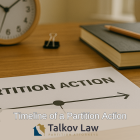Resolve Property Disputes Without Out-of-Pocket Costs
Disputes between co-owners in Ontario can be overwhelming, but the law provides a clear path to resolution. Talkov Law assists Ontario property owners in navigating co-ownership challenges with expertise in real estate law, ensuring successful outcomes through partition actions.
- Zero Partitions Denied
- 500+ Partition Cases Filed
- Most Cases Resolved in Under 7 Months
- No Fees Unless You Win!
Call Now at (909) 577-3300

Begin the Process of Solving Your Partition Dispute
Our attorneys are ready to help at every stage of your partition case. We do the legal work so you can focus on progress.
Co-Ownership Conflict? Not Anymore.
We settle co-ownership disputes efficiently, usually in under 7 months, with nothing due upfront.
We’re the only California real estate law firm exclusively practicing partition actions, and at Talkov Law we’ve helped hundreds in your situation.
Claim Your Free Consultation
Speak with our partition attorneys for free and learn how the law protects your equity.

Start the Legal Action Process

Unlock Your Share Now
What is a Partition Action?
A partition action is a court-supervised process that forces the sale or division of jointly owned real estate when co-owners cannot agree.
Common Scenarios
- Disagreements over selling a jointly purchased property
- Properties bought with an ex-partner
- Friends who purchased land but cannot agree how to use it
In California, any co-owner has an absolute right to partition real property under California Code of Civil Procedure 872.710.

Trusted Partition Lawyers for Hundreds of Californians
From complex legal battles to life-changing victories, our clients share how Talkov Law helped them find clarity, confidence, and success.
Frequently Asked Questions About Ontario Partition Actions
Whether you’re unsure about forcing a sale, concerned about costs, or curious about the timeline, this FAQ addresses the most common issues co-owners face. If your question isn’t listed, your free case consultation is just a click away.
📞 Call (877) PARTITION 📞
What happens if the property can't be physically divided in Ontario?
If physical division isn't practical in a California Partition Action, the court in Los Angeles may order the property to be sold and the proceeds divided among the co-owners.
What happens if a co-owner won't cooperate in Ontario?
In Los Angeles, if a co-owner refuses to cooperate in a Partition Action, the court can order the sale of the property and distribute the proceeds among the co-owners according to their ownership interests.
Can I recover attorney's fees in Ontario?
In a California Partition Action, such as in Los Angeles, attorney's fees can be recovered if the court finds it equitable, typically by allocating them as part of the costs of the partition among the parties involved.
What if a co-owner made improvements or paid more in Ontario?
In Ontario, California, if a co-owner has made significant improvements or paid more towards the property, the court may consider these contributions when dividing the proceeds in a partition action, potentially awarding a larger share to the contributing party.

Ontario Real Estate and Legal Data
- In Ontario, the median home value is around $600,000.
- Ontario has an estimated population of 185,010.
- The average rent in Ontario is around $2,200 per month, as of 2024..
At Talkov Law, our Ontario Lawyers have resolved partition disputes in under 7 months with our expert partition strategies.
Why Choose Talkov Law for Your Partition Case?
- Top Performer: 470+ Partition Matters and counting
- Exclusive Focus: The only California firm devoted exclusively to partition law
- Unparalleled Record: 16+ years with 100% partition approvals


Partition Attorneys Serving All of San Bernardino County
Our attorneys have extensive experience handling partition actions across San Bernardino County.
Local Expertise in Neighborhoods Like: Riverside, San Bernardino, and Chino Hills. Also Serving Areas in:Lake County, Villa Park, Saratoga, Norwalk, and Fairfield.
Your case will likely be heard at the San Bernardino County Superior Court, located at 247 West Third Street, San Bernardino, CA 92415.


































































































































